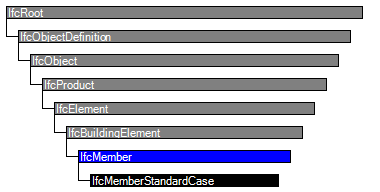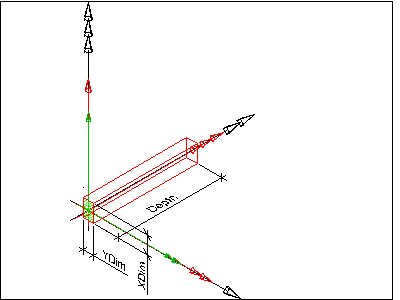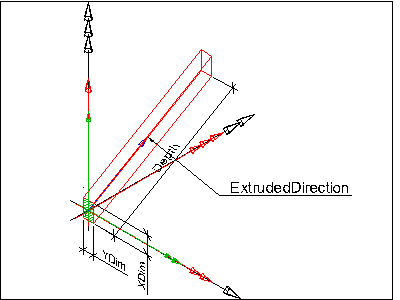Natural language names
 | Stab / Stabträger |
 | Member |
 | Membre |
 | Stab / Stabträger |
 | Member |
 | Membre |
| Item | SPF | XML | Change | Description | IFC2x3 to IFC4 |
|---|---|---|---|---|
| IfcMember | ||||
| OwnerHistory | MODIFIED | Instantiation changed to OPTIONAL. | ||
| PredefinedType | ADDED | IFC4x1 to IFC4x2 | ||
| IfcMember | ||||
| PositionedFrom | ADDED |
An IfcMember is a structural member designed to carry loads between or beyond points of support. It is not required to be load bearing. The orientation of the member (being horizontal, vertical or sloped) is not relevant to its definition (in contrary to IfcBeam and IfcColumn). An IfcMember represents a linear structural element from an architectural or structural modeling point of view and shall be used if it cannot be expressed more specifically as either an IfcBeam or an IfcColumn.
NOTE The representation of a member in a structural analysis model is provided by IfcStructuralCurveMember being part of an IfcStructuralAnalysisModel.
The IFC specification provides two entities for member occurrences:
NOTE View definitions and implementer agreements may further constrain the applicable geometry types, such as by excluding tapering from an IfcMemberStandardCase implementation.
HISTORY New entity in IFC2x2 Addendum 1.
| # | Attribute | Type | Cardinality | Description | B |
|---|---|---|---|---|---|
| 9 | PredefinedType | IfcMemberTypeEnum | [0:1] |
Predefined generic type for a member that is specified in an enumeration. There may be a property set given for the predefined types.
NOTE The PredefinedType shall only be used, if no IfcMemberType is assigned, providing its own IfcMemberType.PredefinedType. | X |
| Rule | Description |
|---|---|
| CorrectPredefinedType | Either the PredefinedType attribute is unset (e.g. because an IfcMemberType is associated), or the inherited attribute ObjectType shall be provided, if the PredefinedType is set to USERDEFINED. |
| CorrectTypeAssigned | Either there is no member type object associated, i.e. the IsTypedBy inverse relationship is not provided, or the associated type object has to be of type IfcMemberType. |

| # | Attribute | Type | Cardinality | Description | B |
|---|---|---|---|---|---|
| IfcRoot | |||||
| 1 | GlobalId | IfcGloballyUniqueId | [1:1] | Assignment of a globally unique identifier within the entire software world. | X |
| 2 | OwnerHistory | IfcOwnerHistory | [0:1] |
Assignment of the information about the current ownership of that object, including owning actor, application, local identification and information captured about the recent changes of the object,
NOTE only the last modification in stored - either as addition, deletion or modification. | X |
| 3 | Name | IfcLabel | [0:1] | Optional name for use by the participating software systems or users. For some subtypes of IfcRoot the insertion of the Name attribute may be required. This would be enforced by a where rule. | X |
| 4 | Description | IfcText | [0:1] | Optional description, provided for exchanging informative comments. | X |
| IfcObjectDefinition | |||||
| HasAssignments | IfcRelAssigns @RelatedObjects | S[0:?] | Reference to the relationship objects, that assign (by an association relationship) other subtypes of IfcObject to this object instance. Examples are the association to products, processes, controls, resources or groups. | X | |
| Nests | IfcRelNests @RelatedObjects | S[0:1] | References to the decomposition relationship being a nesting. It determines that this object definition is a part within an ordered whole/part decomposition relationship. An object occurrence or type can only be part of a single decomposition (to allow hierarchical strutures only). | ||
| IsNestedBy | IfcRelNests @RelatingObject | S[0:?] | References to the decomposition relationship being a nesting. It determines that this object definition is the whole within an ordered whole/part decomposition relationship. An object or object type can be nested by several other objects (occurrences or types). | X | |
| HasContext | IfcRelDeclares @RelatedDefinitions | S[0:1] | References to the context providing context information such as project unit or representation context. It should only be asserted for the uppermost non-spatial object. | ||
| IsDecomposedBy | IfcRelAggregates @RelatingObject | S[0:?] | References to the decomposition relationship being an aggregation. It determines that this object definition is whole within an unordered whole/part decomposition relationship. An object definitions can be aggregated by several other objects (occurrences or parts). | X | |
| Decomposes | IfcRelAggregates @RelatedObjects | S[0:1] | References to the decomposition relationship being an aggregation. It determines that this object definition is a part within an unordered whole/part decomposition relationship. An object definitions can only be part of a single decomposition (to allow hierarchical strutures only). | X | |
| HasAssociations | IfcRelAssociates @RelatedObjects | S[0:?] | Reference to the relationship objects, that associates external references or other resource definitions to the object.. Examples are the association to library, documentation or classification. | X | |
| IfcObject | |||||
| 5 | ObjectType | - | This attribute is out of scope for this model view definition and shall not be set. | ||
| IsTypedBy | IfcRelDefinesByType @RelatedObjects | S[0:1] | Set of relationships to the object type that provides the type definitions for this object occurrence. The then associated IfcTypeObject, or its subtypes, contains the specific information (or type, or style), that is common to all instances of IfcObject, or its subtypes, referring to the same type. | X | |
| IsDefinedBy | IfcRelDefinesByProperties @RelatedObjects | S[0:?] | Set of relationships to property set definitions attached to this object. Those statically or dynamically defined properties contain alphanumeric information content that further defines the object. | X | |
| IfcProduct | |||||
| 6 | ObjectPlacement | IfcObjectPlacement | [0:1] | Placement of the product in space, the placement can either be absolute (relative to the world coordinate system), relative (relative to the object placement of another product), or constraint (e.g. relative to grid axes). It is determined by the various subtypes of IfcObjectPlacement, which includes the axis placement information to determine the transformation for the object coordinate system. | X |
| 7 | Representation | IfcProductRepresentation | [0:1] | Reference to the representations of the product, being either a representation (IfcProductRepresentation) or as a special case a shape representations (IfcProductDefinitionShape). The product definition shape provides for multiple geometric representations of the shape property of the object within the same object coordinate system, defined by the object placement. | X |
| ReferencedBy | IfcRelAssignsToProduct @RelatingProduct | S[0:?] | Reference to the IfcRelAssignsToProduct relationship, by which other products, processes, controls, resources or actors (as subtypes of IfcObjectDefinition) can be related to this product. | X | |
| IfcElement | |||||
| 8 | Tag | IfcIdentifier | [0:1] | The tag (or label) identifier at the particular instance of a product, e.g. the serial number, or the position number. It is the identifier at the occurrence level. | X |
| ConnectedTo | IfcRelConnectsElements @RelatingElement | S[0:?] | Reference to the element connection relationship. The relationship then refers to the other element to which this element is connected to. | ||
| HasOpenings | IfcRelVoidsElement @RelatingBuildingElement | S[0:?] | Reference to the IfcRelVoidsElement relationship that creates an opening in an element. An element can incorporate zero-to-many openings. For each opening, that voids the element, a new relationship IfcRelVoidsElement is generated. | X | |
| ConnectedFrom | IfcRelConnectsElements @RelatedElement | S[0:?] | Reference to the element connection relationship. The relationship then refers to the other element that is connected to this element. | X | |
| ContainedInStructure | IfcRelContainedInSpatialStructure @RelatedElements | S[0:1] | Containment relationship to the spatial structure element, to which the element is primarily associated. This containment relationship has to be hierachical, i.e. an element may only be assigned directly to zero or one spatial structure. | ||
| PositionedFrom | IfcRelPositions @RelatingElement | S[0:1] | Indicates a constrained placement, where the ObjectPosition must match positioning defined according to the referenced positioning element. | X | |
| IfcBuildingElement | |||||
| IfcMember | |||||
| 9 | PredefinedType | IfcMemberTypeEnum | [0:1] |
Predefined generic type for a member that is specified in an enumeration. There may be a property set given for the predefined types.
NOTE The PredefinedType shall only be used, if no IfcMemberType is assigned, providing its own IfcMemberType.PredefinedType. | X |
Members are used to represent linear members with primary function of axial loading such as angles as part of cross-bracing. The general definition IfcMember defines a fixed shape, while the subtype IfcMemberStandardCase allows for parametric resizing.
Object Typing
The Object Typing concept applies to this entity as shown in Table 32.
| ||
Table 32 — IfcMember Object Typing |
| Exchange | ||||
|---|---|---|---|---|
| Import | O | |||
| Export | O |
Quantity Sets
The Quantity Sets concept applies to this entity as shown in Table 33.
| ||
Table 33 — IfcMember Quantity Sets |
| Exchange | ||||
|---|---|---|---|---|
| Import | O | |||
| Export | O |
Element Decomposition
The Element Decomposition concept applies to this entity as shown in Table 34.
| ||||
Table 34 — IfcMember Element Decomposition |
| Exchange | ||||
|---|---|---|---|---|
| Import | ||||
| Export |
Element Nesting
The Element Nesting concept applies to this entity as shown in Table 35.
| ||||
Table 35 — IfcMember Element Nesting |
The nesting relationship may be used to indicate nesting of member segments onto full lengths of raw material.
| Exchange | ||||
|---|---|---|---|---|
| Import | O | |||
| Export | O |
Body SweptSolid Geometry
The Body SweptSolid Geometry concept applies to this entity as shown in Table 36.
| ||||||||||||||||
Table 36 — IfcMember Body SweptSolid Geometry |
The following additional constraints apply to the 'SweptSolid' representation type:
Figure 179 illustrates the 'SweptSolid' geometric representation. There are no restrictions or conventions on how to use the local placement (black), solid of extrusion placement (red) and profile placement (green).
 |
Figure 179 — Beam swept solid |
Figure 180 illustrates the use of non-perpendicular extrusion to create the IfcExtrudedAreaSolid.
 |
Figure 180 — Beam non-perpendicular extrusion |
| Exchange | ||||
|---|---|---|---|---|
| Import | ||||
| Export |
Annotation 2D Geometry
The Annotation 2D Geometry concept applies to this entity as shown in Table 37.
| ||||||||||||||||
Table 37 — IfcMember Annotation 2D Geometry |
For fabrication, piece marks, pop marks, and contour marks may be designated using the 'Annotation' representation.
| Exchange | ||||
|---|---|---|---|---|
| Import | ||||
| Export |
Surface Connectivity
The Surface Connectivity concept applies to this entity as shown in Table 38.
| ||
Table 38 — IfcMember Surface Connectivity |
This relationship is used to indicate connections between members and other elements such as plates. The intersecting surface may be provided to indicate precisely where the member is attached, and to assist fabrication for indicating contour marking and/or weld locations.
| Exchange | ||||
|---|---|---|---|---|
| Import | R | R | ||
| Export | R | R |
| # | Concept | Model View |
|---|---|---|
| IfcRoot | ||
| Software Identity | Bridge View | |
| User Identity | Bridge View | |
| Object Ownership | Bridge View | |
| IfcObject | ||
| Property Sets for Objects | Bridge View | |
| IfcElement | ||
| Element Occurrence Attributes | Bridge View | |
| Product Local Placement | Bridge View | |
| Product Assignment | Bridge View | |
| IfcMember | ||
| Object Typing | Bridge View | |
| Quantity Sets | Bridge View | |
| Element Decomposition | Bridge View | |
| Element Nesting | Bridge View | |
| Body SweptSolid Geometry | Bridge View | |
| Annotation 2D Geometry | Bridge View | |
| Surface Connectivity | Bridge View | |
<xs:element name="IfcMember" type="ifc:IfcMember" substitutionGroup="ifc:IfcBuildingElement" nillable="true"/>
<xs:complexType name="IfcMember">
<xs:complexContent>
<xs:extension base="ifc:IfcBuildingElement">
<xs:attribute name="PredefinedType" type="ifc:IfcMemberTypeEnum" use="optional"/>
</xs:extension>
</xs:complexContent>
</xs:complexType>
ENTITY IfcMember
SUPERTYPE OF(IfcMemberStandardCase)
SUBTYPE OF (IfcBuildingElement);
PredefinedType : OPTIONAL IfcMemberTypeEnum;
WHERE
CorrectPredefinedType : NOT(EXISTS(PredefinedType)) OR
(PredefinedType <> IfcMemberTypeEnum.USERDEFINED) OR
((PredefinedType = IfcMemberTypeEnum.USERDEFINED) AND EXISTS (SELF\IfcObject.ObjectType));
CorrectTypeAssigned : (SIZEOF(IsTypedBy) = 0) OR
('IFCSHAREDBLDGELEMENTS.IFCMEMBERTYPE' IN TYPEOF(SELF\IfcObject.IsTypedBy[1].RelatingType));
END_ENTITY;